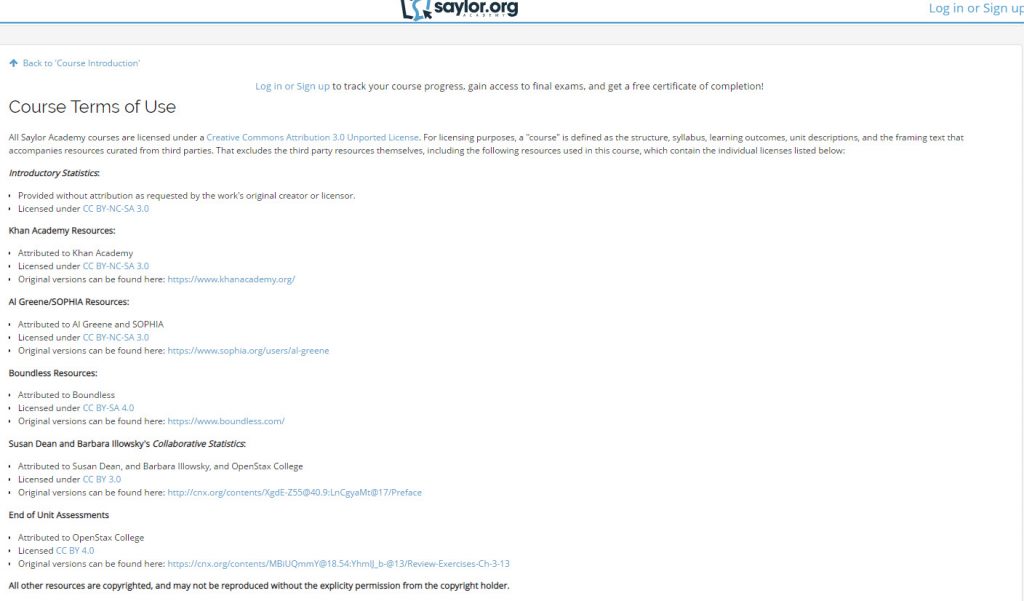Using Creative Commons Licenses
Now that you know how the licenses work and how they are designed, you are ready to use CC licenses for your own work and reuse CC licensed works created by others. This unit covers what you need to know as a CC licensor and as a reuser. When your own CC licensed work incorporates CC licensed work made by others, you are both!
What should creators consider before applying a CC license to their work? There are several options for creators who choose to share using CC. There are also many things to think about before applying any CC license, including whether you have all the rights you need and if not, how you must indicate that to the public.
Learning Objectives
By the end of this chapter, you will have
- discovered how to create a CC license
- explored how to apply a CC license
Personal Reflection/Why it Matters to You
How would you go about choosing a particular CC license for your work? Do you know how to go about actually attaching a license to your work once you have chosen one? What if you change your mind about the license? Share your thoughts in the Hypothes.is annotation layer of this resource.
The act of applying a CC license is easy, but as you consider whether you want to apply a CC license to your creative work, there are some important things to think through.
Applying a Creative Commons License
It’s important to understand that the licenses are irrevocable. Irrevocable means a legal agreement that cannot be canceled. That means once you apply a CC license to a work, the CC license applies to the work until the copyright on the work expires. This aspect of CC licensing is highly desirable from the perspective of reusers because they have confidence knowing the creator can’t arbitrarily pull back the rights granted them under the CC license. Because the licenses are irrevocable, it is very important to carefully consider the options before deciding to use a CC license on a work.
You must own or control copyright in the work. You should control copyright in the work to which you apply the license. For example, you don’t own or control any copyright in a work that is in the public domain, and you don’t own or control the copyright to an Enrique Iglesias song. Further, if you created the material in the scope of your employment, you may not be the holder of the rights and may need to get permission from your employer before applying a CC license. Before licensing, be mindful about whether you have copyright to the work to which you’re applying a CC license.
Which Creative Commons License Should You Use?
There are six Creative Commons licenses which provide a range of options for creators who want to share their work with the public while still retaining copyright. The best way to decide which license is appropriate for you is to think about why you want to share and how you hope others will use your work.
For example, you might consider whether you think people might make interesting new works out of your creation. Do you want to give people the ability to translate your writing into different languages, or otherwise customize it for their own needs? If you find those possibilities intriguing, then you should choose a license that allows your work to be adapted. The CC license chooser can help you decide which license might be best for you.
How do I apply a CC license to my work?
Once you’ve decided you want to use a CC license and know which license you want to use, applying it is simple. Technically, all you have to do is indicate which CC license you are applying to your work. However, we strongly recommend including a link (or writing out the CC licence URL, if you are working offline) to the relevant CC license deed (e.g., https://creativecommons.org/licenses/by/4.0). You can do this in the copyright notice for your work, on the footer of your website, or any other place that makes sense in light of the particular format and medium of your work. The important thing is to make it clear what the CC license covers and locate the notice in a place that makes that clear to the public. See Marking your work with a CC license for more information.
If you are on a platform like Medium or Flickr, you should use the built-in CC licence tools on the platform to mark your work with the CC license you choose. If you have a personal blog or a website, we recommend using the CC license chooser to generate code that identifies your chosen license. That code can be copied and inserted into your work online.
Take some time to play around with the CC license chooser now. After you select the boxes that indicate your preferences, the chooser generates the appropriate license based on your selections. Remember, the license chooser is not a registration page, it simply provides you with standardized HTML code, icons and license statements.
If you want to mark the work in a different way or need to use a different format like closing titles in a video, you can visit https://creativecommons.org/about/downloads/ and access downloadable versions of all of the CC icons.
CC License Marking
Whatever method you use to mark your content, there are several important steps for proper CC license marking. You will want to mark your own work so that others can easily discover, reuse it and give you credit and attribution. You will want to mark work by others upon which your work was based, and you will want to mark work by others which you have included in your work.
The best practice for marking your work is to follow the TASL approach for your own portions of the content, and for the portions of the content created by others:
T = Title
A = Author (tell reusers who to give credit to)
S = Source (give reusers a link to the resource)
L = License (link to the CC licence deed)
When providing attribution, the goal is to mark the work with full TASL information. When you don’t have some of the TASL information about a work, do the best you can and include as much detail as possible in the marking statement.
Note, that starting with Version 4.0 the licenses no longer require a reuser to include the title as part of the attribution statement. However, if the title is provided, then CC encourages you to include it when attributing the author. For more examples of how to mark your own work in different contexts, spend some time looking through CC’s extensive marking page.
See below for an example of marking an original image with TASL information. The following image is a good example of CC marking because TASL with all appropriate links is provided in the attribution statement.

When your work is a modification or adaptation of another work, indicate this and provide attribution to the creator of the original work. You should also include a link to the piece from which you created your modification and indicate what license applies to that work. See below for an example using TASL to indicate the creation is based on someone else’s work.

When your work incorporates work by others, indicate this and provide attribution to the creator of the original work. See below for an example of Saylor Academy using TASL to indicate the work incorporates work by others.
In every case, the goals are the same: you want to make it easy for others to know who created what parts of the work. (1) Identify the terms under which any given work, or part of a work, can be used. (2) Provide information about works you used to create your new work or incorporated into your work.
There is no single answer for which CC license is the best. It is important to remember why you are sharing and what you hope others might do with your work, before making your CC license choice.
Check for Understanding
What if . . .
But what if you simply want to sell a CC licensed work?
If you are the creator, then selling your work is always okay. In fact, selling physical copies (e.g., a textbook) and providing the digital copies for free is a very common method for making money while using CC licenses. Here is a prominent example from CC’s Team Open feature: Max Temkin, founder of Cards Against Humanity:
Stack of Cards Against Humanity packs by jareed. CC BY 2.0.
What if you change your mind about the CC license?
Inevitably, there are creators who apply a CC license to a work and then later decide they want to offer it on different terms. Even though the original license cannot be revoked, the creator is free to also offer the work under a different license. Similarly, the creator is free to remove the copy of the work they placed online. In those cases, anyone who finds the work under the original license is legally permitted to use it under those terms until the copyright expires. As a practical matter, reusers may want to comply with the creator’s new wishes as a matter of respect.
What if someone does something with my CC licensed work I don’t like?
As long as users abide by license terms and conditions, authors / licensors cannot control how their material is used. That said, all CC licenses provide several mechanisms that allow licensors to choose not to be associated with their material, or to uses of their material with which they disagree.
- First, all CC licenses prohibit using the attribution requirement to suggest that the licensor endorses or supports a particular use.
- Second, licensors may waive the attribution requirement, choosing not to be identified as the licensor, if they wish.
- Third, if the licensor does not like how the material has been modified or used, CC licenses require that the licensee remove the attribution information upon request. (In 3.0 and earlier, this is only a requirement for adaptations and collections; in 4.0, this also applies to the unmodified work.)
- Finally, anyone modifying licensed material must indicate that the original has been modified. This ensures that changes made to the original material–whether or not the licensor approves of them–are not attributed back to the licensor.
- Further, it is important to remember:
- The Commons is full of good people who want to do the right thing, so we don’t often see much “abuse” of openly licensed works. Using CC licenses gives good, responsible people the freedom to use and build on your work.
- Copyright and/or open copyright licenses doesn’t keep “bad” people from doing “bad” things with your work if they don’t care about copyright.
Wrapping Up
Attribution is arguably the single most important aspect of Creative Commons licensing. Think about why you want credit for your own work, even when it may not be legally required. What value does attribution provide to authors, and to the public who comes across the work online?
When applying a CC license to a work: 1) Use the CC license chooser to determine which CC license best meets your needs. Apply the license code if possible, or copy / paste the text and links provided. 2) If you are using an online platform, use the built-in CC license tools to mark your work with a CC license. 3) Mark your work and give proper attribution to others’ works using the TASL approach.



